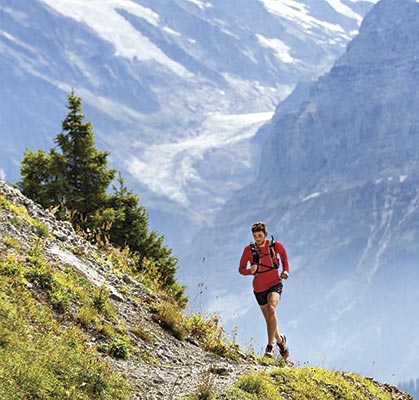Hills Are for Heroes

How to maximize the benefits of steep climbs in your training
Hills can be a trail runner’s best friend for building both physical and mental strength. Photo by PatitucciPhoto
Over 50 years ago, legendary coach Arthur Lydiard would send his top track athletes on grueling long runs throughout New Zealand’s Waitakere Ranges. These workouts entailed over 1,500 feet of vertical gain and were unconventional for the likes of middle-distance professionals such as Peter Snell.
But they paid off.
After completing these workouts, Snell went on to win two gold medals at the 1964 Olympics (800 meters and 1,500 meters). Certainly, some of his fitness and mental confidence came from these long, hilly workouts in the mountains.
But what exactly do hills do for you and how should you train on them?
Gravity is Good for You
Elite distance coach Brad Hudson, of the Boulder-based Marathon Performance Training Group, is a huge proponent of hill training and says that long climbs give athletes a double bonus. “They strengthen the muscular system and the aerobic system at the same time,” says Hudson.
The combination of the hill’s gravity with your body weight creates a resistance-type workout. “You can almost think of doing a hill repeat like doing a long squat at the gym,” he says. “It’s super specific and much better than going to a weight room.”
Physiological benefits aside, there are also mental advantages to hill training. Nikki Kimball, a three-time winner of the grueling Western States 100-Mile Endurance Run, says that training on hills prepares the mind for race day. “People sometimes dread hills,” she says. “Going into a race knowing you prepared on hills takes that fear away. When properly trained, I crave hills in races as I know I can gain time there on competitors.”
Hudson agrees: “A hill climb teaches you to be able to run hard on your own, because it’s just a constant strain from step one.”
Three Hill Workouts to Incorporate into Your Training
1. Short-and-steep bursts
- What: Fast accelerations at maximum intensity up a steep hill for eight to 12 seconds per repetition.
- When: Once a week at the end of one of your regular training runs.
- How: End your run at the base of a steep hill (the steeper the better). After you’ve cooled down, complete six to eight bursts and recover after each repeat with a jog back down.
- Why: These intense climbs recruit all the muscle fibers in your legs and build strength. Think of them like lifting heavy weights in a gym.
2. Mid-run repeats
- What: Quick sprints of approximately one minute.
- When: Once or twice a week, spliced into a moderate training run.
- How: In the middle of your run, find a hill that will take you a minute or so to climb. Do four to six climbs up the hill with a jog back down after each repeat.
- Why: To give you the mental edge on race day when you find yourself flagging and have to climb a tough hill. These workouts can also help break up the monotony of a longer run.
4. Long climbs
- What: Gradual, less-steep hill repeats of one to three miles.
- When: Treat this as its own hard workout on one or two days a week.
- How: Warm up on a flat trail for a few miles. Ease into the climb at first and increase intensity in the second half. Do two to three repeats on a one-mile hill, or a single climb on a two- to three-mile hill. Recovery is an easy-paced run back to the starting point.
- Why: To develop fatigue resistance and build endurance for races with a lot of undulating terrain.
This article originally appeared in our June 2014 issue.